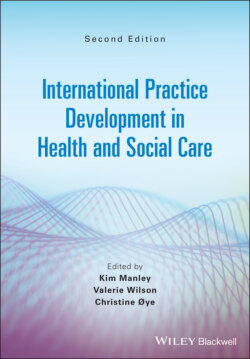Читать книгу International Practice Development in Health and Social Care - Группа авторов - Страница 19
The key concepts and structure of the book
ОглавлениеWe have radically changed the structure of this book compared with its first edition, reversing the theory and practice examples. We start the book with a strong focus on practice and then in the second part look at how theory links to practice. We have reversed this focus because people are inspired by practice‐related stories that demonstrate the impact that PD has. We hope the stories stimulate a deepening interest in the reasons that account for how transformation happens in practice, demystifying the way forward through exploring the key concepts necessary for understanding and use.
The first section, comprising six chapters, describes PD principles in action, either with different client groups or in different settings and system levels. We commence with a focus on the voice of people with stomas and mental health challenges, and how these voices are heard and acted upon in relation to a dedicated health service (Chapter 2). Chapter 4 in contrast focuses on whole communities and what needs to be considered when developing and designing sustainable person‐centred communities and integrated person‐centred systems.
Chapters 3 and 5 focus on people and their experiences across the life span, from the time surrounding birth and the needs of women and their partners through this transformative experience, moving then to the other end of life to focus on what matters to older people experiencing care in various settings.
As alluded to earlier, PD integrates active learning in and from practice with improving and developing, and also research and inquiry. Chapter 6 focuses on the practical use of educational models that embed PD values in practice, exploring the impact of these and how the workplace is a powerful resource for these activities. Chapter 7 concludes with examples of embedded research using critical ethnography, an approach commonly used in PD to understand the culture of the workplace collaboratively.
The second part of the book explores PD insights and concepts under four broad interdependent themes:
theoretical perspectives;
facilitation;
leadership;
flourishing cultures.
Developments in our theoretical understanding start with Chapter 8 revising the principles of PD originally developed in the 2008 edition. Based on experiences of people across all countries involved in the International Practice Development Collaborative, the revision enables greater clarity about the key purposes and processes of PD, making it more accessible to not just practitioners and those facilitating them but also commissioners and managers who may be better able to employ the distinct and original support PD can provide towards transformation of services and systems.
Much of PD has been based on the theoretical perspective of critical theory from social science. Chapter 9 revisits this theory to provide contemporary insights about its use and value.
Chapter 10 demystifies facilitation. Facilitation enables others to live their values, learn, and become more person‐centred and compassionate, as well as effective, through self‐awareness from reflection and helping people to understand the impact they have on others. Chapter 11 focuses on the multiple purpose of facilitation at different levels in the system.
Three chapters on leadership follow, whereas there was only one in the 2008 edition. This is because leadership in tandem with facilitation is a critical enabler to culture change at every level of health and social care. Everyone can be a leader on something and often we become followers and leaders to each other at different times in different contexts. Chapter 12 focuses on relationship‐based leadership approaches; Chapter 13 on team leadership to develop flourishing cultures informed by a multiprofessional clinical leadership programme underpinned by PD principles; and Chapter 14 on systems leadership.
The remaining theme, flourishing cultures, includes the latest research (Chapter 15), staff wellbeing at work (Chapter 16), and the concept of flourishing in the context of people, families and communities experiencing health and social care (Chapter 17).
Chapter 18 concludes with a position for the future in relation to the role of PD in continuing inquiry and innovation, capturing the celebrations and aspirations of the International Practice Development Collaborative.
